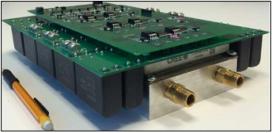Electric Vehicles Inverter Developed with Twice the Efficiency, Smaller Size than Commercial Systems
Researchers at the NSF-funded Future Renewable Electric Energy Delivery and Management (FREEDM) Systems Engineering Research Center (ERC), headquartered at North Carolina State University, have designed, fabricated, and tested a high-power inverter for electric vehicles (EV) that nearly doubles the system efficiency of commercial systems while reducing size and weight by 20 percent.
The ERC’s open-source development of the inverter technology can be commercialized for automotive and other industries. The inverter’s reduced size and weight, and efficiency improvements, will aid in the design of high-speed, high power density electric powertrain systems that raise the fuel economy of electric vehicles, making them more commercially viable.
The ERC engineered the Silicon Carbide-based (SiC) system to improve the efficiency of the inverter, while reducing its size and weight. The gate-driver component developed and tested by the ERC reduced the height of the inverter’s ultra-low profile to 6mm from 12mm, improved the dv/dt immunity (>100 kV/µs), increased the wide-switching frequency range to 200 kHz, and widened the operating temperature range from -40°C to 125°C.
One power module was used for the interleaved DC-DC boost stage while three other power modules were paralleled for the inverter stage to reach the 55kW power level. The bidirectional DC-DC converter at the front stage increased the typical battery voltage of 200 V–450 V to 200 V–700 V, with an interleaved structure that significantly reduces the input DC current ripple and adds flexibility to the DC bus stage. The boost topology enables the use of a high DC bus voltage that can be adjusted based on the system operating condition.
The passive components of the power plane are optimally incorporated into the inverter design around the SiC power modules. A low-profile gate driver and controller are integrated at the system level, significantly reducing the volume of the inverter and increasing its power density, while providing very high efficiency.



